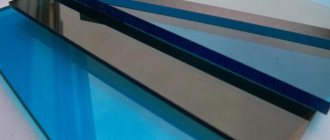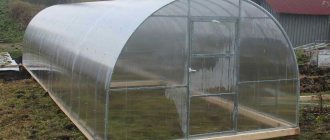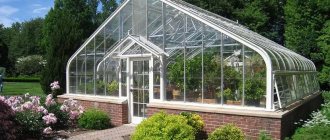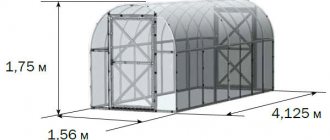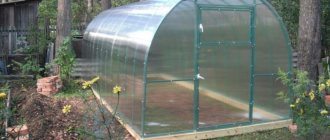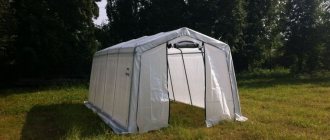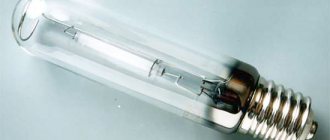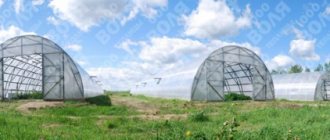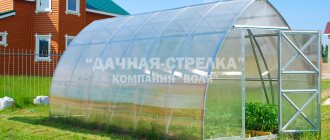Siberia is a formidable region with a very unfavorable climate for most plants. But this is outside, but greenhouses make it possible to grow any crops even in such conditions. Naturally, this requires special greenhouses - Siberian ones. One of the representatives of the designated family is shown in the photo.
Polycarbonate "Siberian Greenhouses"
Cellular polycarbonate of the Siberian Greenhouses trade brand is moisture-resistant, resistant to high and low temperatures, exposure to ultraviolet radiation, chemical compounds, and sudden temperature changes.
We offer to buy material in St. Petersburg in our online store. There is a wide selection of panels made in standard sizes, in a variety of colors, with different sheet thicknesses. Prices from . Select the required quantity of goods based on the colors and dimensions specified below
Frost-resistant plastic
For areas with harsh climatic conditions, cellular polycarbonate of the Siberian Greenhouses brand, produced in standard sizes, including the size 4x2100x6000mm, is perfect. The polymer is actively used in construction, industry, and the advertising industry.
Cellular polycarbonate with the Siberian Greenhouses brand, having a transparent color and a thickness of 4 mm, is successfully used to cover buildings intended for growing plants:
This plastic, like Berolux polycarbonate, copes well with heavy snow and rain loads, a wide temperature range, and has:
- High strength index.
- Resistance to ultraviolet radiation, moisture, mechanical and chemical influences.
- Heat and sound insulation properties.
- small specific gravity,
- plasticity,
- flexibility,
- tear resistance.
You can buy polycarbonate for fences in a wide range of colors for a long period of use.
We offer to purchase thermoplastics of the Siberian Greenhouses, Berolux and Borrex polycarbonate brands in our online store at prices from the manufacturer.
Source of the article: https://polikarbonat-online.ru/polikarbonat-yug-oyl-plast/sibirskie-teplicy/
Heavy-duty Greenhouse Siberian
Are you buying a greenhouse? Pay attention! Choosing a greenhouse can be complicated by the fact that popular models are often counterfeited. Unscrupulous manufacturers often use thin metal and low-quality “handicraft” painting. When buying Kremlevskaya, make sure that there are logos on the packaging. You can also purchase a greenhouse directly from the manufacturer on the official website: https://www.neoform.su/
I have been looking for such information for a long time, and now I asked myself the same question: who should I trust? Four years ago I bought a greenhouse with polycarbonate from a Moscow manufacturer, I don’t remember exactly which one, hoping that, as written, the service life would be up to 10 years. But that’s not the case, this spring it’s just crumbling, in the literal sense of the word. There was a strong wind recently, and a piece was torn off. It’s a shame, but I bought it back then for 2100 per sheet, it was advertised as the best.
Purchasing an inexpensive material made by a company that has no name or does not list one will most likely be a waste of money. Such plastic usually will not last the specified period and will have to be replaced with a better one in the near future. When choosing cellular polycarbonate for a greenhouse, you should focus on your own financial capabilities and avoid substandard products.
There are many types of transparent plastic on the Russian market, manufactured by domestic and foreign manufacturers. Let's consider the most common brands of cellular polycarbonate, presented by different manufacturers. For the convenience of data analysis, the article will describe two-layer panels 4 mm thick with stiffeners perpendicular to its surface.
#video_insert_place
Cellular polycarbonate 4mm “Siberian Greenhouses”
Select the required quantity of goods based on the colors and dimensions specified below
|
All products are certified
The polycarbonate brand “Siberian Greenhouses” fully lives up to its name. The material is adapted to the harsh climatic conditions that characterize the regions of Siberia and some other regions. The features of this polymer are excellent protection against:
- high humidity;
- severe frosts;
- sudden changes in temperature;
- ultraviolet radiation.
Our company is pleased to offer cellular colored and transparent polycarbonate sheets of the Siberian Greenhouses brand at competitive prices. The thickness of the panels is 4 mm. Sheet width is 2.1 m, length options are 3, 6 or 12 meters. Has 11 color options.
Transparent cellular plastic is perfect for constructing greenhouses. Excellent light conductivity and thermal insulation ability provide the ability to create and maintain optimal light and temperature conditions inside the structure. Colored versions of the polymer of this thickness are used for decorative vertical glazing, conductive mesh roofing in small architectural structures, as well as for advertising purposes.
Transparent cast polycarbonate also has a wide range of uses. The store invites you to buy such material.
Source of the article: https://polikarbonat-online.ru/katalog/sotovyj-polikarbonat/4mm-sibtepl/
Polycarbonate Siberian greenhouses: characteristics and reviews
Siberia is a harsh region with a very unfavorable climate for most plants. However, this is outside, but greenhouses make it possible to grow any crops even in such conditions. Of course, this requires special greenhouses - Siberian ones. One of the representatives of this family is shown in the photo.
Polycarbonate greenhouse
Features of the climate of Siberia
The period favorable for growing vegetables and other crops in open ground is very short in Siberia and ranges from 80 to 100 days, and this is in relatively warm areas of this region. The main reason for this severity is the cold - winters here are long, snow can remain until the end of May - beginning of June. At the same time, the summer itself is short, and frosts may begin as early as August, threatening to destroy everything that grows on the plot. In addition, the soil in Siberia freezes greatly during the winter, up to 2-3 meters.
Greenhouse "Sibirskaya" ХХХХL
The harsh continental climate with significant temperature changes does not make it more attractive for growing vegetables and berries. And the last important factors that make Siberia a harsh region are strong winds and a general lack of sunlight. Due to the latter factor, the cultivation of some agricultural crops becomes completely impossible.
The Sibirskaya greenhouse is the best option for harsh winters
The Sibirskaya greenhouse appeared in such conditions as an effective and relatively inexpensive solution to the problems faced by summer residents. How does it work and how to build it yourself? You can find answers to these questions in this article.
Specifications
- Siberian greenhouses are made of high-quality galvanized pipes, the square cross-section of which is twenty by twenty millimeters, and the wall thickness is one millimeter.
- The strength of the structure is also ensured by the cross method of fastening its parts.
- Siberian greenhouses have an arched frame. The walls of the structure, for the cladding of which polycarbonate is used, have four through openings - two doors and the same number of vents.
- These structures can be installed both on the foundation and on the ground. If installation is carried out on the ground, T-shaped legs are used.
- Assembly and installation of the frame requires the participation of no more than two people. Polycarbonate is also quite easy to install.
- Siberian greenhouses make it possible to grow early vegetables, flowers, seedlings and other crops of agricultural importance.
- These structures can change their length using special devices - modular inserts.
- The polycarbonate with which Siberian greenhouses are sheathed has a standard thickness of four millimeters. The building material is also endowed with the ability to protect the insides of structures from ultraviolet radiation.
- The polycarbonate used for structures of this type has a ten-year guarantee.
- The warranty period for the operation of the greenhouses themselves is fifty years.
A little about the manufacturers
The first manufacturer that will be discussed now is called “Siberian Greenhouses”. This company produces excellent products that can be safely used in the harsh conditions of Siberian winters. The reinforced frame and high-quality polycarbonate provide the structures with strength and durability. It is these characteristics that summer residents respect and value.
The production process meets all established standards. Raw materials, including polycarbonate, have appropriate certificates, and finished products have a long warranty period.
Another manufacturer, called Sibirsky Metallotsentr CJSC, also produces structures such as greenhouses. The frames of these structures, onto which polycarbonate is then attached, are manufactured using high-tech equipment, which gives a 100% guarantee of product quality.
All materials supplied to production are purchased from the largest importers of galvanized steel. In addition, the company itself also conducts thorough testing of raw materials.
Polycarbonate, used for cladding the walls and ceilings of greenhouses, has a quality certificate that fully complies with all established standards.
Thus, the greenhouses produced by this manufacturer fully comply with GOST.
The photo shows a greenhouse, which is the creation of this manufacturer.
It should be noted that all greenhouse manufacturers use polycarbonate, which also lends itself to all sorts of tests. Fastening elements are made from appropriate raw materials and are quite suitable for the installation of greenhouses installed in the mentioned conditions.
Eventually
The climatic conditions that Mother Nature has endowed Siberia with do not make it possible to grow vegetables, flowers and other vegetation. This can only be done if the necessary atmosphere is created artificially. This is exactly why engineers and designers have created such a wonderful thing as a greenhouse, which allows you to harvest crops in the middle of the harsh Siberian winter.
The galvanized frame, as well as polycarbonate, copes well with their functions not only in winter, but also in an unstable temperature environment, which is typical for autumn and spring.
The photo shows several modifications of Siberian greenhouses.
Proven greenhouses for Siberia
2017 turned out to be a very snowy year.
I think for Siberia, 2-meter snowdrifts are not uncommon, especially in lowlands or near forested areas. There were a lot of greenhouse breakdowns.
How can a summer resident in the Siberian region protect himself from such troubles?
Let’s immediately note the answer options that you just need to clean the greenhouse or put up supports.
The first is impossible for summer residents, the second is unreliable, since when the ground freezes, it “moves” and the racks can either weaken and fall, or, on the contrary, squeeze out the roof.
This means there are two options left - either a very durable greenhouse, an example of which is the Kama-50 produced in Yanaul, or a greenhouse with a sharp or opening roof. Example - “Nurse-Clever”, Novosibirsk.
“Kama-50” is a classic arched greenhouse with solid ends and arcs made of a 20x20mm profile pipe painted with a polymer coating, 1.5mm thick and located at a distance of 50cm. The window in this greenhouse is independent of the door and is located either above the door (opens upward) or on the side of the door (opens to the side). This design has proven its effectiveness - high strength is achieved at a relatively low price.
“Clever nurse” - thanks to the opening roof, snow gets inside the greenhouse, which protects the soil from freezing in the winter, and in the spring provides timely moisture and creates favorable conditions for planting seedlings.
The greenhouse delivery kit includes:
- galvanized frame;
- retractable roof;
- roof opening mechanism;
- 2 doors.
As a gift, a set of horizontal trellises to strengthen the structure and garter plants, a pusher for the roof.
These can be purchased, for example, by residents of Tomsk. They are sold by the company located at st. Elizarov, 26.
What consumers are talking about
Reviews left by consumers indicate that Siberian greenhouses are quite convenient in terms of transportation. This operation can be carried out even using passenger vehicles.
In addition to the fact that these structures are easy to assemble, and the polycarbonate can be fixed independently, Siberian greenhouses can also be extended if such a need arises. These features allow you to save on labor costs, as well as install additional racks to grow more crops. Reviews from summer residents also indicate that planting can be done in two levels.
The installation of these greenhouses does not require pouring a foundation, which is very convenient in the climatic conditions for which such structures are intended. Installation does not take much effort and time, which is appreciated by consumers.
Reviews also indicate that Siberian greenhouses have excellent strength and can withstand quite heavy loads. Such characteristics make it possible not to dismantle buildings associated with the onset of winter, since they are not afraid of any winds or snowfalls.
Marking the site and creating a foundation
Work on creating a “Siberian” greenhouse begins with choosing the site on which it will be located. First, assess the light level - plants in the greenhouse should be exposed to the sun during the day for as long as possible, shading from nearby buildings or trees is undesirable. Secondly, study the landscape - is there a slope and in which direction, how difficult will it be to level the area. Thirdly, the “Siberian” greenhouse must be correctly oriented to the cardinal points - the narrow ends face west and east, and the long walls face north and south, respectively.
Greenhouse layout diagram
The correct solution would be to install a greenhouse at a distance of a couple of meters from the fence on the northern border of the site - the fence will protect the building from the cold wind.
The next step in building a greenhouse is preparing the construction site. Clear the soil of plants, stones and small debris and level it. Mark the area using pegs (or pieces of reinforcement) driven into the ground and a rope stretched between them. Check whether the diagonals between the corners of the future greenhouse are equal.
Preparing the site for the foundation
Now it's time to build the foundation. If you don’t have the desire or ability to do it, but want to protect the building from the wind, you can get by with metal pins driven into the ground to a depth of 25 to 50 cm.
Step 1. Determine the gaps through which the pins will be driven. In most cases, the interval between the elements of such a “foundation” is one meter.
Marking scheme
Step 2. When creating the frame, drill holes in the base to match the diameter of the pins or secure metal mounting brackets in the same places.
Step 3. Place the base on the ground and level it horizontally.
Step 4. Install the pins into the holes on the base of the frame or into the brackets and begin driving them into the ground. There should be about 10-15 cm of the pin above the ground level.
Pin locations
The pin is driven into the ground
Step 5. Bend the ends of the pins into an “L” shape.
The pins are bent
On a note! A further development of the idea of a greenhouse on pins could be the use of screw piles or T-posts.
If you decide to make a foundation for a greenhouse, then the simplest option would be a structure made of wooden beams with a section of 150x150 or 100x100 mm. The material should not have significant defects or a large number of knots.
Step 1: Mark out the foundation using pegs and string. Check the evenness of the diagonals.
Marking the site for a timber foundation
Step 2. Dig a trench to fit the width of the timber to a depth of 10 to 20 cm.
Step 3. Cut the timber into pieces of the required length.
Timber cutting
Step 4. Treat the material with an antiseptic, bitumen mastic or copper sulfate.
Step 5. Pour fine gravel, sand, or a mixture of both into the trench and compact it thoroughly.
Step 6. Lay timber around the perimeter of the trench. Check whether it lies evenly and whether the lengths of the diagonals match.
Diagram of a timber foundation
Step 7. Connect the timber using corners and self-tapping screws. An alternative could be a “half-tree” connection using the same self-tapping screws or pieces of reinforcement driven into the joints as fasteners.
Methods for connecting timber
Step 8. Insert metal pins or anchor bolts along the perimeter of the foundation at intervals of 1 m. Subsequently, with their help, you will fix the base of the greenhouse frame to the beam.
If you follow the technology for treating timber with an antiseptic, the foundation of the greenhouse will last you about the same as its cladding - 8-10 years.
Block foundation - an alternative option
And for those who are interested in greater durability, there is a foundation on bottles, concrete and brick.
Glass bottle foundation
Step 1: Collect a large number of empty glass bottles of approximately the same size. Wash them and dry them.
Step 2. Dig a trench about 0.5 m deep for the foundation.
Step 3: Place a sand or gravel bed at the bottom of the trench.
Sand cushion for the foundation
Step 4. Make the first layer of bottles - along the perimeter of the trench, with the neck towards the outside. Sprinkle them with soil or fill them with concrete. But remember that for good adhesion to glass you will need high-quality cement.
Step 5. Using the method described in step 4, lay 4 more layers of bottles.
Installation of a bottle base
Step 6. Sprinkle 5-1 layers of soil and lay red brick on top of it (in two layers).
Step 7. Insert anchor bolts or pins into the layer of mortar between the brick blocks, to which the frame will be attached in the future.
To grow crops in an area with a very unfavorable climate, a reasonable solution would be to create a thermos greenhouse. Unlike the usual “Sibirskaya”, it is dug into the ground almost its entire height, and only the roof remains above the ground. The design of a thermos greenhouse resembles a dugout, and with artificial lighting and heating, you can grow vegetables and berries in it even in winter.
Example of a thermos greenhouse
Prices for timber
timber
